Linking Short- to Medium-Term Beach Dune Dynamics to Local Features under Wave and Wind Actions: A Northern Portuguese Case Study
Abstract
:1. Introduction
2. Materials and Methods
2.1. Study Area
2.2. Data
2.2.1. Surveys and Elevation Models
2.2.2. Wave Conditions
2.2.3. Wind Conditions
2.3. Analyses
3. Results
3.1. Overall Morphodynamics
3.2. Local Morphodynamics
4. Discussion
4.1. Overall Morphodynamics
4.2. Local Morphodynamics
5. Conclusions
Author Contributions
Funding
Institutional Review Board Statement
Informed Consent Statement
Acknowledgments
Conflicts of Interest
References
- Nel, R.; Campbell, E.E.; Harris, L.; Hauser, L.; Schoeman, D.S.; McLachlan, A.; du Preez, D.R.; Bezuidenhout, K.; Schlacher, T.A. The status of sandy beach science: Past trends, progress, and possible futures. Estuar. Coast. Shelf Sci. 2014, 150, 1–10. [Google Scholar] [CrossRef]
- Newton, A.; Weichselgartner, J. Hotspots of coastal vulnerability: A DPSIR analysis to find societal pathways and responses. Estuar. Coast. Shelf Sci. 2014, 140, 123–133. [Google Scholar] [CrossRef]
- Jones, A.; Phillips, M. Disappearing Destinations: Climate Change and Future Challenges for Coastal Tourism; CABI: Oxfordshire, UK, 2010; p. 273. [Google Scholar]
- Lobeto, H.; Menendez, M.; Losada, I.J. Future behavior of wind wave extremes due to climate change. Sci. Rep. 2021, 11, 7869. [Google Scholar] [CrossRef] [PubMed]
- Syvitski, J.P.M.; Vörösmarty, C.J.; Kettner, A.J.; Green, P. Impact of humans on the flux of terrestrial sediment to the global coastal ocean. Science 2005, 308, 376–380. [Google Scholar] [CrossRef] [PubMed]
- European Communities. Living with Coastal Erosion in Europe–Sediment and Space for Sustainability; Office for Official Publications of the European Communities: Luxembourg, 2004. [Google Scholar]
- Pollard, J.A.; Spencer, T.; Brooks, S.M. The interactive relationship between coastal erosion and flood risk. Prog. Phys. Geogr. 2019, 43, 574–585. [Google Scholar] [CrossRef] [Green Version]
- Vousdoukas, M.I.; Ranasinghe, R.; Mentaschi, L.; Plomaritis, T.A.; Athanasiou, P.; Luijendijk, A.; Feyen, L. Sandy coastlines under threat of erosion. Nat. Clim. Chang. 2020, 10, 260–263. [Google Scholar] [CrossRef]
- Antunes, C. Assessment of sea level rise at West Coast of Portugal Mainland and its projection for the 21st century. J. Mar. Sci. Eng. 2019, 7, 61. [Google Scholar] [CrossRef] [Green Version]
- Turner, R.K.; Burgess, D.; Hadley, D.; Coombes, E.; Jackson, N. A cost-benefit appraisal of coastal managed realignment policy. Glob. Environ. Chang. 2007, 17, 397–407. [Google Scholar] [CrossRef]
- Williams, A.T.; Rangel-Buitrago, N.; Pranzini, E.; Anfuso, G. The management of coastal erosion. Ocean Coast. Manag. 2018, 156, 4–20. [Google Scholar] [CrossRef]
- Lima, M.; Coelho, C.; Veloso-Gomes, F.; Roebeling, P. An integrated physical and cost-benefit approach to assess groins as a coastal erosion mitigation strategy. Coast. Eng. 2020, 156, 103614. [Google Scholar] [CrossRef]
- Rangel-Buitrago, N.; Williams, A.T.; Anfuso, G. Hard protection structures as a principal coastal erosion management strategy along the Caribbean coast of Colombia. A chronicle of pitfalls. Ocean Coast. Manag. 2018, 156, 58–75. [Google Scholar] [CrossRef]
- Stronkhorst, J.; Huisman, B.; Giardino, A.; Santinelli, G.; Santos, F.D. Sand nourishment strategies to mitigate coastal erosion and sea level rise at the coasts of Holland (The Netherlands) and Aveiro (Portugal) in the 21st century. Ocean Coast. Manag. 2018, 156, 266–276. [Google Scholar] [CrossRef]
- Granja, H.; Bastos, L.; Pinho, J.; Gonçalves, J.; Henriques, R.; Bio, A.; Magalhães, A. Small Harbours Risks: Lowering for Fishery and Increasing Erosion. The Case of Portinho da Aguda (NW Portugal); Littoral 2010; EDP Sciences: Les Ulis, France, 2011; p. 09003. [Google Scholar] [CrossRef] [Green Version]
- Vieira, B.F.V.; Pinho, J.L.S.; Barros, J.A.O.; Antunes do Carmo, J.S. Hydrodynamics and morphodynamics performance assessment of three coastal protection structures. J. Mar. Sci. Eng. 2020, 8, 175. [Google Scholar] [CrossRef] [Green Version]
- Semeoshenkova, V.; Newton, A. Overview of erosion and beach quality issues in three Southern European countries: Portugal; Spain and Italy. Ocean Coast. Manag. 2015, 118, 12–21. [Google Scholar] [CrossRef]
- Marinho, B.; Coelho, C.; Hanson, H.; Tussupova, K. Coastal management in Portugal: Practices for reflection and learning. Ocean Coast. Manag. 2019, 181, 104874. [Google Scholar] [CrossRef]
- Guillén, J.; Stive, M.J.F.; Capobianco, M. Shoreline evolution of the Holland coast on a decadal scale. Earth Surf. Process. Landf. 1999, 24, 517–536. [Google Scholar] [CrossRef]
- Van Rijn, L.C. Coastal erosion and control. Ocean Coast. Manag. 2011, 54, 867–887. [Google Scholar] [CrossRef]
- Casella, E.; Rovere, A.; Pedroncini, A.; Stark, C.P.; Casella, M.; Ferrari, M.; Firpo, M. Drones as tools for monitoring beach topography changes in the Ligurian Sea (NW Mediterranean). Geo-Mar. Lett. 2016, 36, 151–163. [Google Scholar] [CrossRef]
- Lemke, L.; Miller, J.K. Role of storm erosion potential and beach morphology in controlling dune erosion. J. Mar. Sci. Eng. 2021, 9, 1428. [Google Scholar] [CrossRef]
- Hinestroza-Mena, K.M.; Toro, V.G.; Londoño-Colorado, G.S.; Chávez, V.; García-Blanco, J.K.; Silva, R. Fine spatial scale, frequent morphological monitoring of urbanised beaches to improve coastal management. J. Mar. Sci. Eng. 2021, 9, 550. [Google Scholar] [CrossRef]
- Flor-Blanco, G.; Alcántara-Carrió, J.; Jackson, D.W.T.; Flor, G.; Flores-Soriano, C. Coastal erosion in NW Spain: Recent patterns under extreme storm wave events. Geomorphology 2021, 387, 107767. [Google Scholar] [CrossRef]
- Ferreira, A.M.; Coelho, C. Artificial nourishments effects on longshore sediments transport. J. Mar. Sci. Eng. 2021, 9, 240. [Google Scholar] [CrossRef]
- Murray, T.; Strauss, D.; Da Silva, G.V.; Wharton, C. Spatial variability in beach morphology with respect to wave exposure along a zeta-shaped coastline. In Proceedings of the 9th International Conference on Coastal Sediments 2019, Tampa/St. Petersburg, FL, USA, 27–31 May 2019; pp. 632–645. [Google Scholar] [CrossRef]
- Vieira Da Silva, G.; Murray, T.; Strauss, D. Longshore wave variability along non-straight coastlines. Estuar. Coast. Shelf Sci. 2018, 212, 318–328. [Google Scholar] [CrossRef]
- Bauer, B.O.; Davidson-Arnott, R.G.D.; Walker, I.J.; Hesp, P.A.; Ollerhead, J. Wind direction and complex sediment transport response across a beach-dune system. Earth Surf. Process. Landf. 2012, 37, 1661–1677. [Google Scholar] [CrossRef]
- Sloss, C.R.; Hesp, P.; Shepherd, M. Coastal Dunes: Aeolian Transport. Nat. Educ. Knowl. 2012, 3, 21. Available online: https://www.nature.com/scitable/knowledge/library/coastal-dunes-aeolian-transport-88264671/ (accessed on 15 April 2022).
- Bauer, B.O.; Davidson-Arnott, R.G.D.; Hesp, P.A.; Namikas, S.L.; Ollerhead, J.; Walker, I.J. Aeolian sediment transport on a beach: Surface moisture, wind fetch, and mean transport. Geomorphology 2009, 105, 106–116. [Google Scholar] [CrossRef]
- Bio, A.; Bastos, L.; Granja, H.; Pinho, J.L.S.; Goncalves, J.A.; Henriques, R.; Madeira, S.; Magalhaes, A.; Rodrigues, D. Methods for coastal monitoring and erosion risk assessment: Two Portuguese case studies. J. Integr. Coast. Zone Manag. 2015, 15, 47–63. [Google Scholar] [CrossRef] [Green Version]
- Taveira Pinto, F. The practice of coastal zone management in Portugal. J. Coast. Conserv. 2004, 10, 147–158. [Google Scholar] [CrossRef]
- APA; ARH Norte; ARH Centro; ARH Tejo e Oeste; ARH Alentejo; ARH Algarve. Plano de Ação Litoral XXI; Agência Portuguesa do Ambiente: Amadora, Portugal, 2017; pp. 1–128.
- Pinto, C.A.; Silveira, T.M.; Teixeira, S.B. Beach nourishment practice in mainland Portugal (1950–2017): Overview and retrospective. Ocean Coast. Manag. 2020, 192, 105211. [Google Scholar] [CrossRef]
- Cruz, J. Ocean Wave Energy: Current Status and Future Perspectives; Green Energy and Technology; Springer: Berlin/Heidelberg, Germany, 2008. [Google Scholar] [CrossRef]
- Viitak, M.; Avilez-Valente, P.; Bio, A.; Bastos, L.; Iglesias, I. Evaluating wind datasets for wave hindcasting in the NW Iberian Peninsula coast. J. Oper. Oceanogr. 2021, 14, 152–165. [Google Scholar] [CrossRef]
- Relvas, P.; Barton, E.D.; Dubert, J.; Oliveira, P.B.; Peliz, Á.; da Silva, J.C.B.; Santos, A.M.P. Physical oceanography of the western Iberia ecosystem: Latest views and challenges. Prog. Oceanogr. 2007, 74, 149–173. [Google Scholar] [CrossRef] [Green Version]
- Benavent, M.; Arnoso, J.; Montesinos, F.G. Regional ocean tide loading modelling around the Iberian Peninsula. J. Geodyn. 2009, 48, 132–137. [Google Scholar] [CrossRef]
- Lorenzo, M.N.; Taboada, J.J.; Gimeno, L. Links between circulation weather types and teleconnection patterns and their influence on precipitation patterns in Galicia (NW Spain). Int. J. Climatol. 2008, 28, 1493–1505. [Google Scholar] [CrossRef]
- Ramos, A.M.; Ramos, R.; Sousa, P.; Trigo, R.M.; Janeira, M.; Prior, V. Cloud to ground lightning activity over Portugal and its association with circulation weather types. Atmos. Res. 2011, 101, 84–101. [Google Scholar] [CrossRef]
- Gonçalves, J.; Bastos, L.; Pinho, J.; Granja, H. Digital aerial photography to monitor changes in coastal areas based on direct georeferencing. In Proceedings of the 5th EARSeL Workshop on Remote Sensing of the Coastal Zone, Prague, Czech Republic, 1–3 June 2011; Available online: http://www.conferences.earsel.org/abstract/show/2689 (accessed on 12 June 2014).
- Gonçalves, J.A.; Bastos, L.; Madeira, S.; Magalhães, A.; Bio, A. Three-dimensional data collection for coastal management–efficiency and applicability of terrestrial and airborne methods. Int. J. Remote Sens. 2018, 39, 9380–9399. [Google Scholar] [CrossRef]
- Agisoft LLC. Agisoft Metashape User Manual Professional Edition, Version 1.8; Agisoft Metashape: 2022. Available online: https://www.agisoft.com/pdf/metashape-pro_1_8_en.pdf (accessed on 15 April 2022).
- Muñoz Sabater, J. ERA5-Land Hourly Data from 1981 to Present; Copernicus Climate Change Service (C3S) Climate Data Store (CDS): Sherfield, UK, 2019. [Google Scholar] [CrossRef]
- Gualtieri, G. Reliability of era5 reanalysis data for wind resource assessment: A comparison against tall towers. Energies 2021, 14, 4169. [Google Scholar] [CrossRef]
- Douglas, D.H.; Peucker, T.K. Algorithms for the reduction of the number of points required to represent a digitized line or its caricature. Cartogr. Int. J. Geogr. Inf. Geovis. 1973, 10, 112–122. [Google Scholar] [CrossRef] [Green Version]
- Dodet, G.; Castelle, B.; Masselink, G.; Scott, T.; Davidson, M.; Floc’h, F.; Jackson, D.; Suanez, S. Beach recovery from extreme storm activity during the 2013–14 winter along the Atlantic coast of Europe. Earth Surf. Process. Landf. 2019, 44, 393–401. [Google Scholar] [CrossRef] [Green Version]
- Nicolae-Lerma, A.; Ayache, B.; Ulvoas, B.; Paris, F.; Bernon, N.; Bulteau, T.; Mallet, C. Pluriannual beach-dune evolutions at regional scale: Erosion and recovery sequences analysis along the Aquitaine coast based on airborne LiDAR data. Cont. Shelf Res. 2019, 189, 103974. [Google Scholar] [CrossRef]
- Murray, A.; Asthon, A. Instability and finite-amplitude self-organization of large-scale coastline shapes. Philos. Trans. R. Soc. A 2013, 371, 20120363. [Google Scholar] [CrossRef]
- Montaño, J.; Coco, G.; Chataigner, T.; Yates, M.; Le Dantec, N.; Suanez, S.; Cagigal, L.; Floc’h, F.; Townend, I. Time-Scales of a Dune-Beach System and Implications for Shoreline Modeling. J. Geophys. Res. Earth Surf. 2021, 126, e2021JF006169. [Google Scholar] [CrossRef]
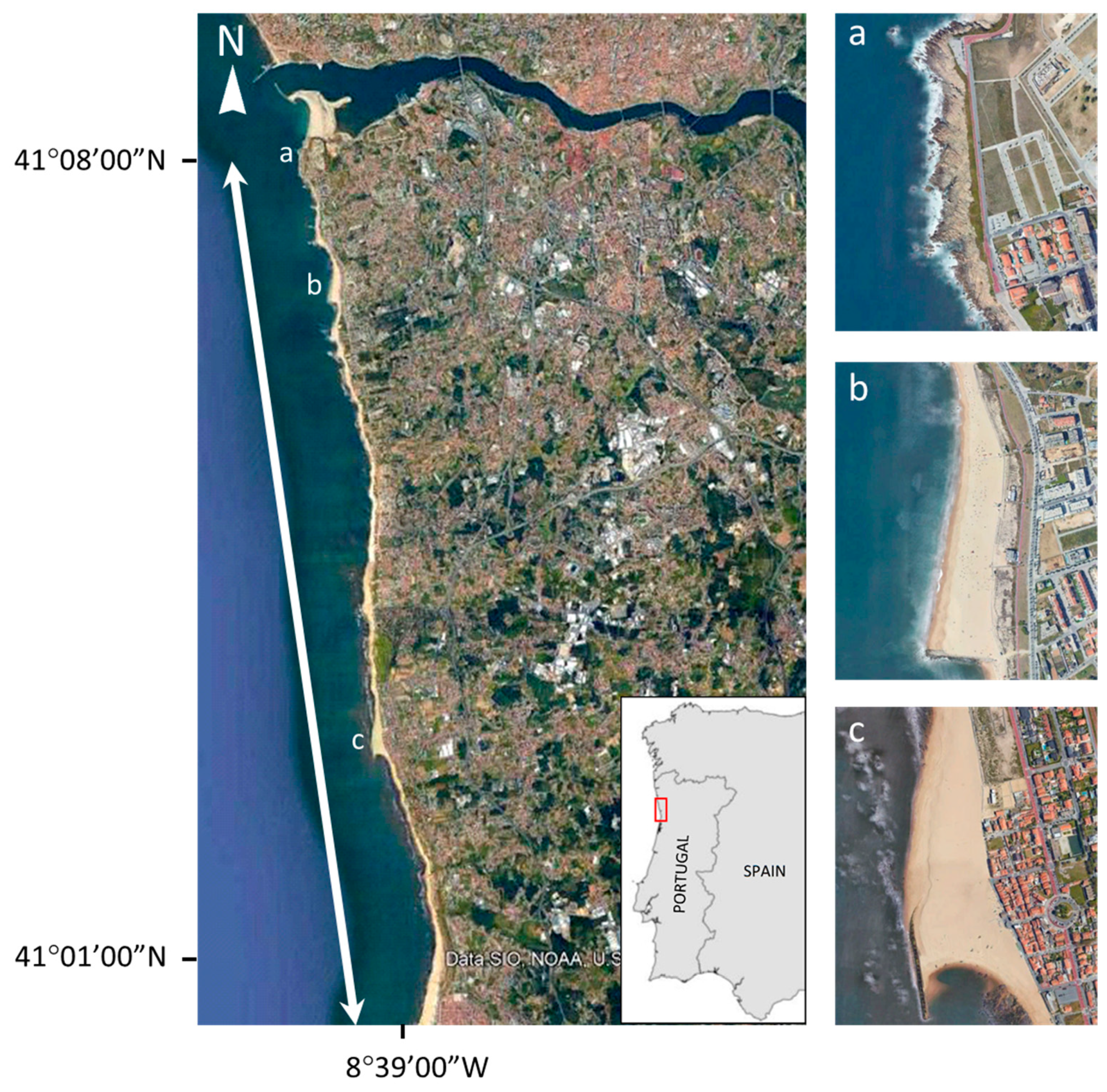

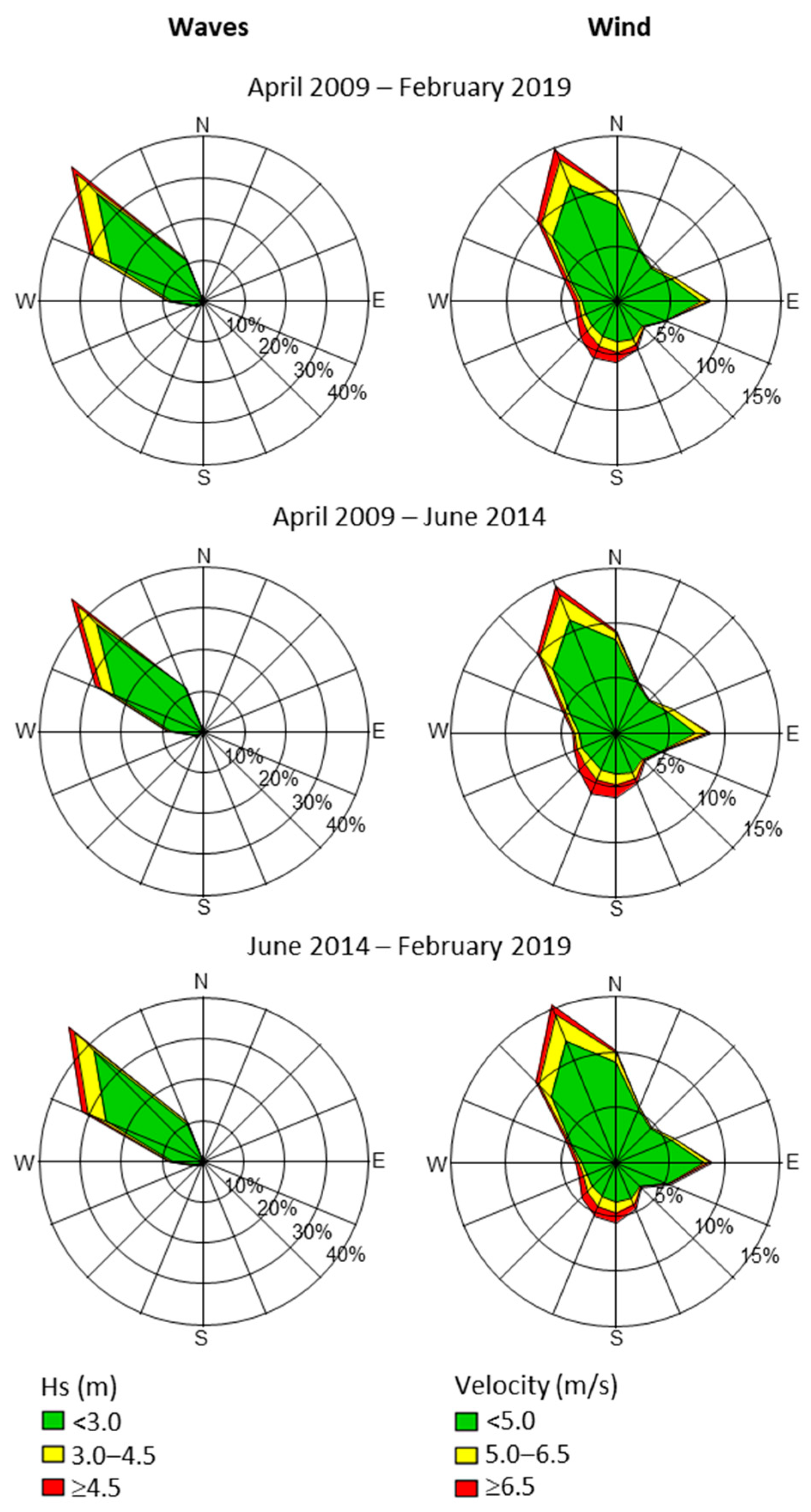
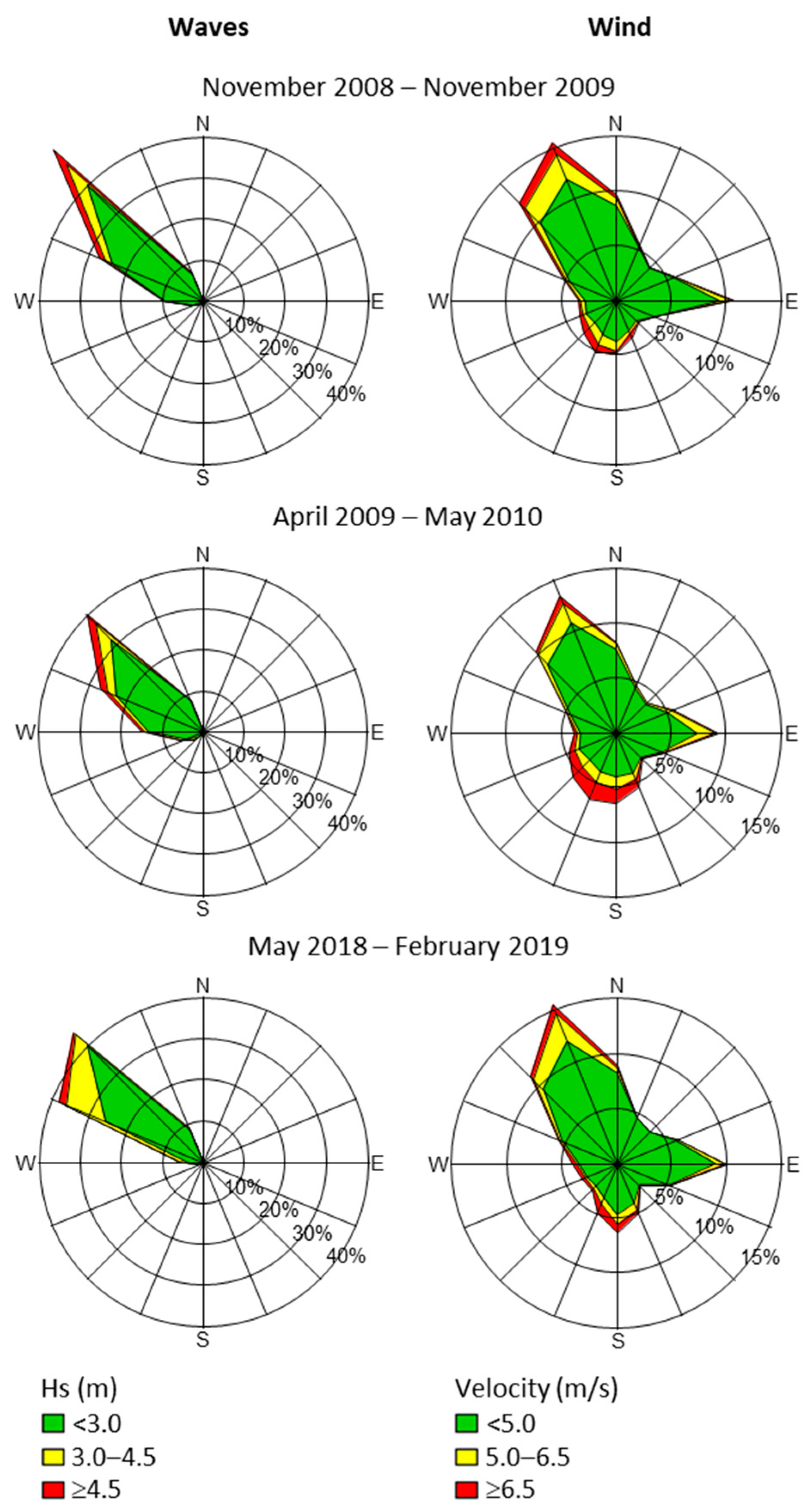
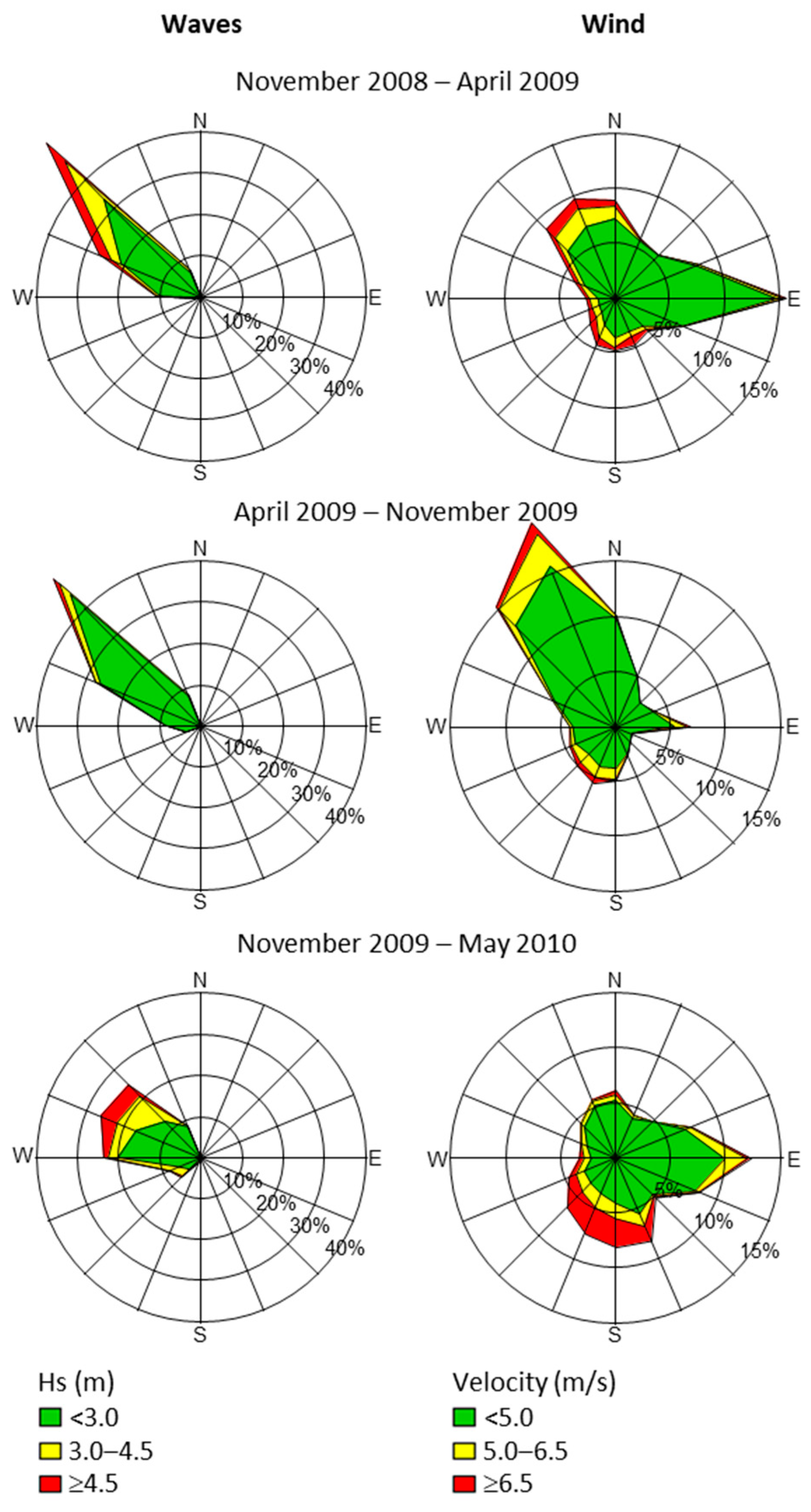

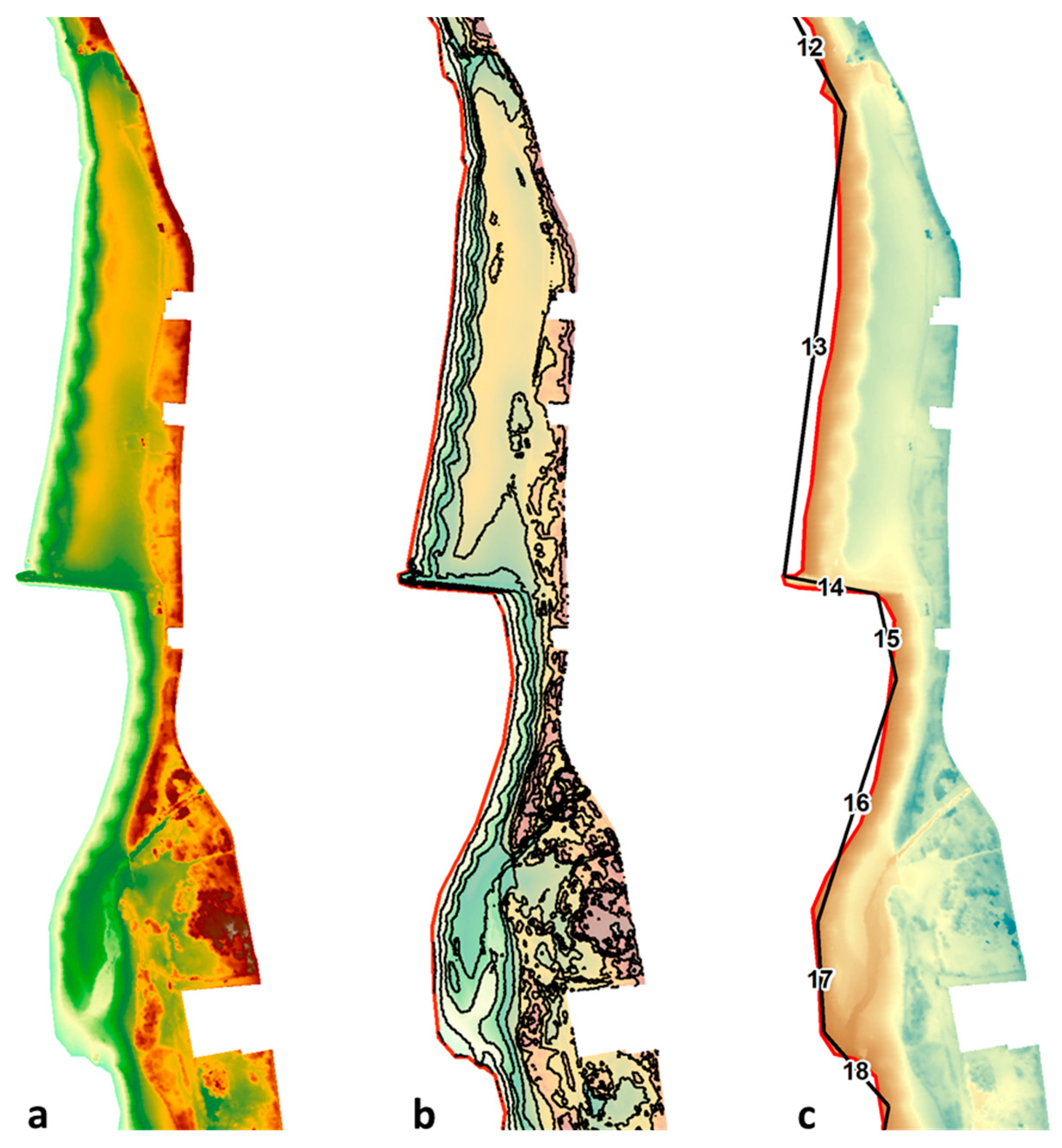
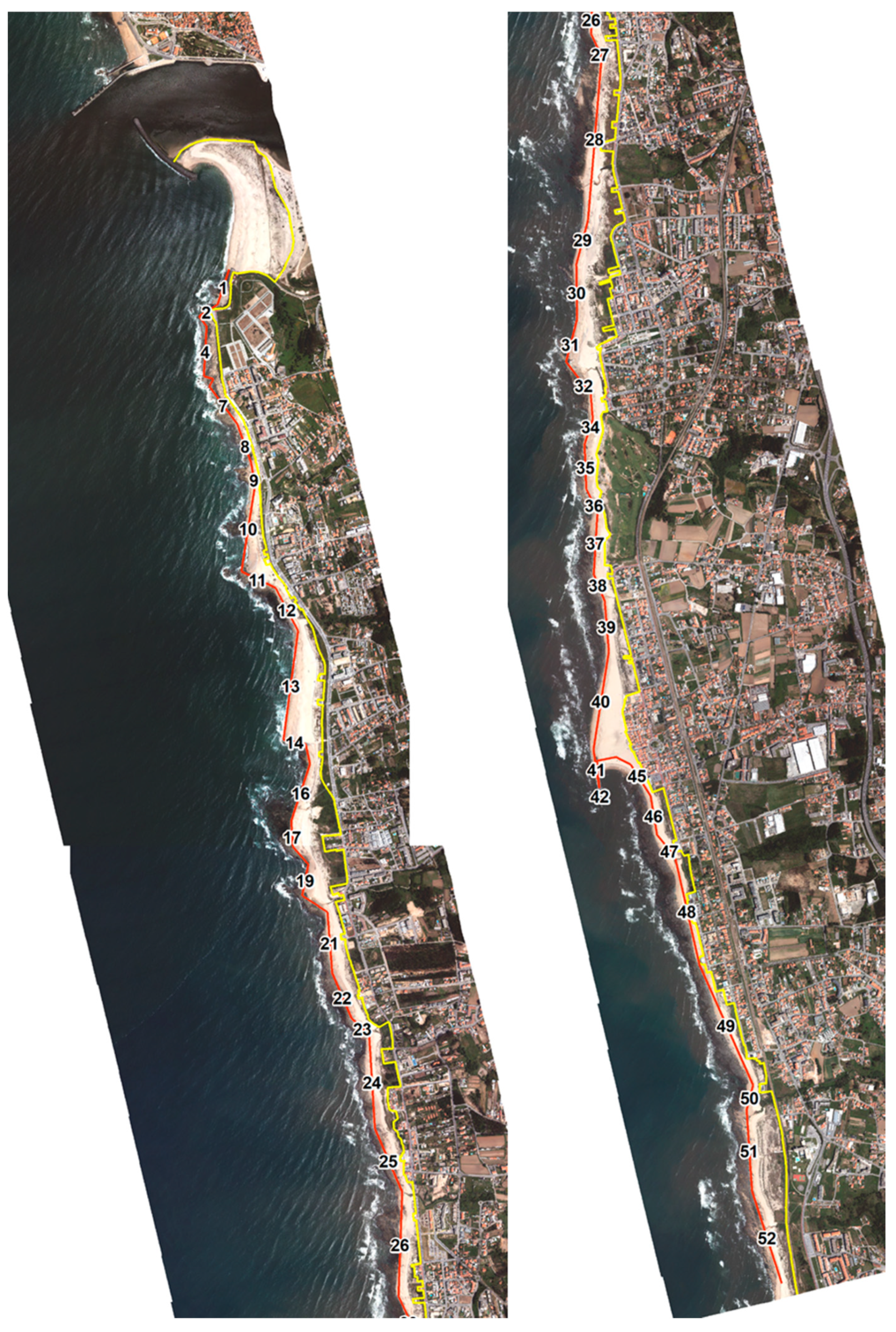
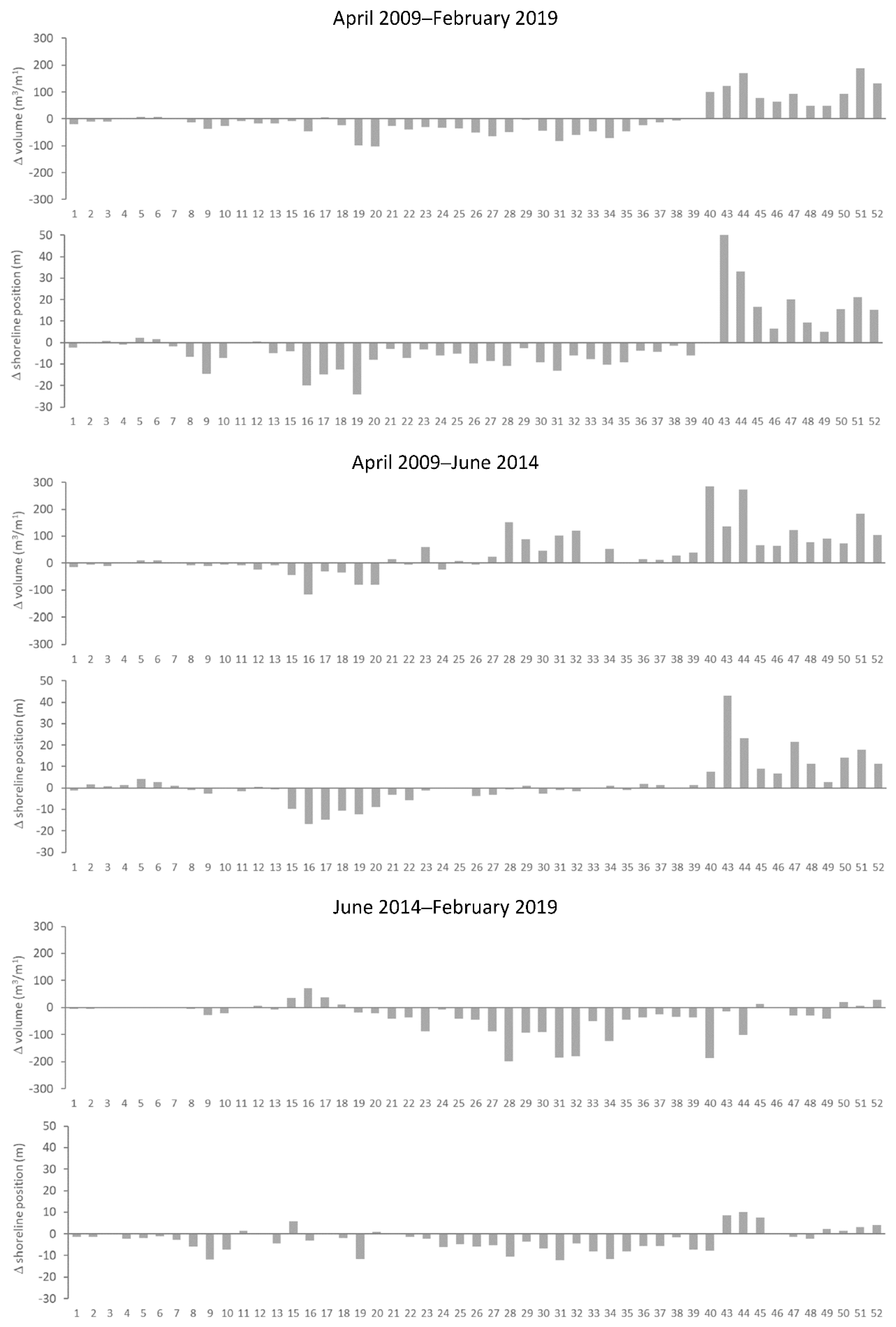
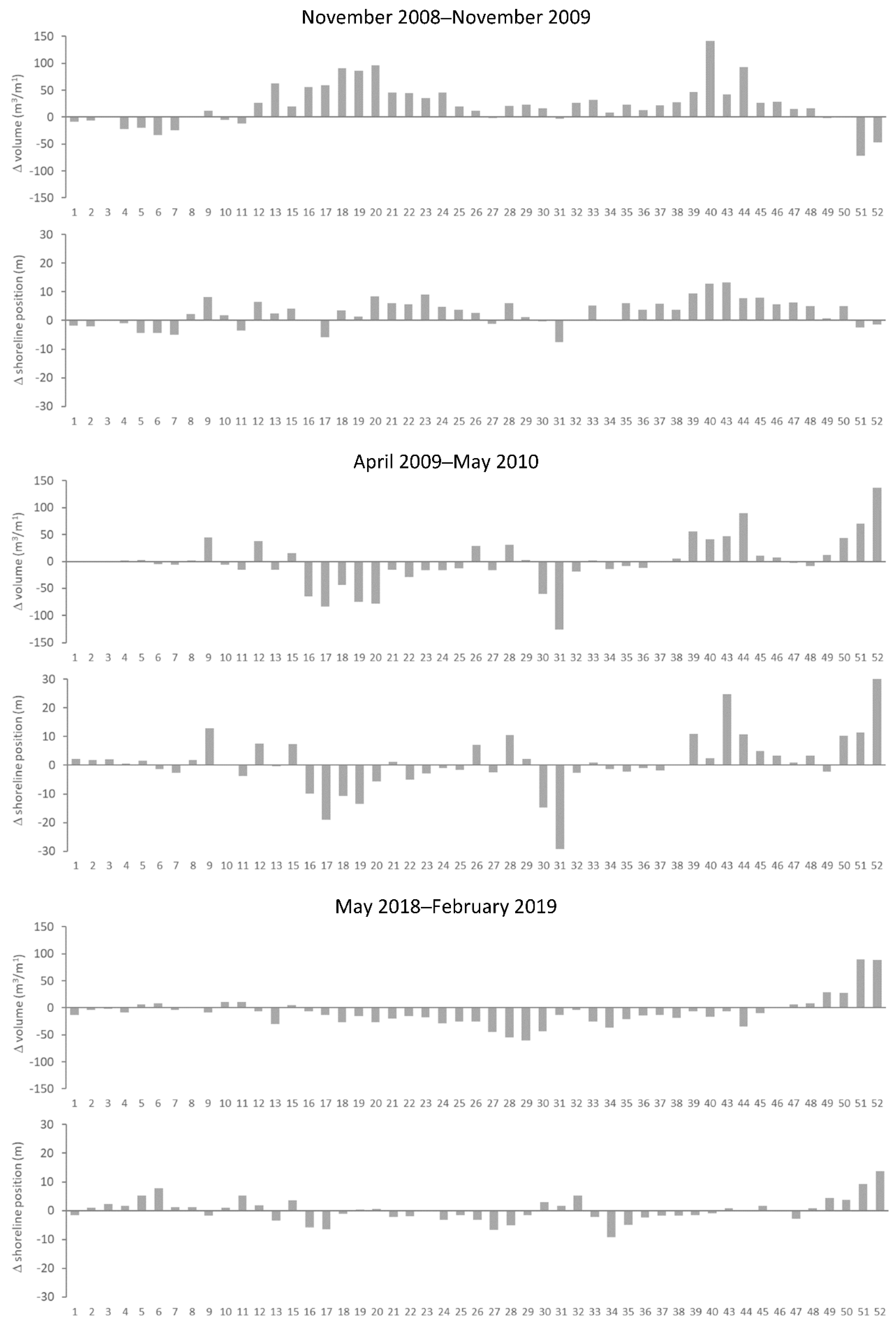
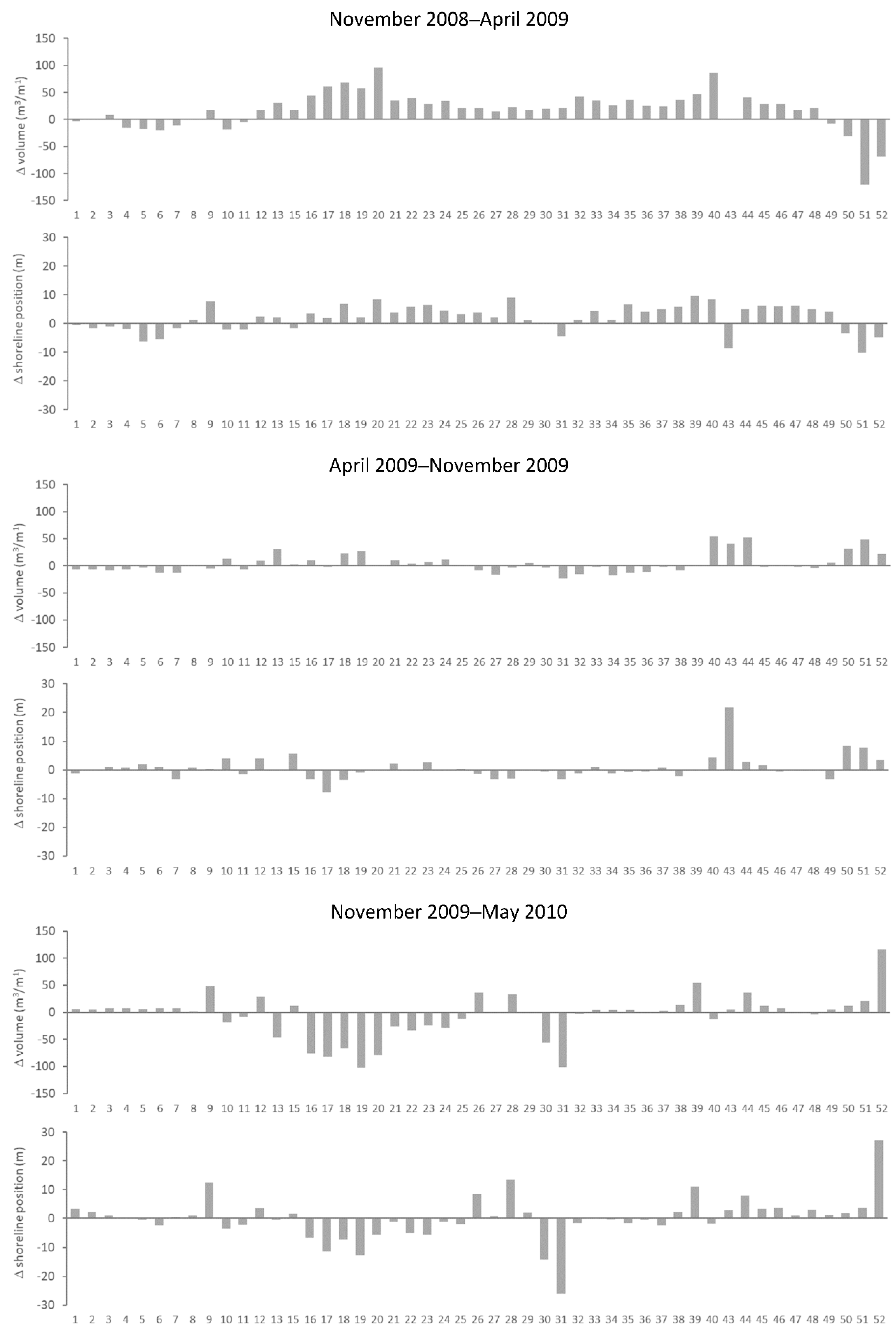
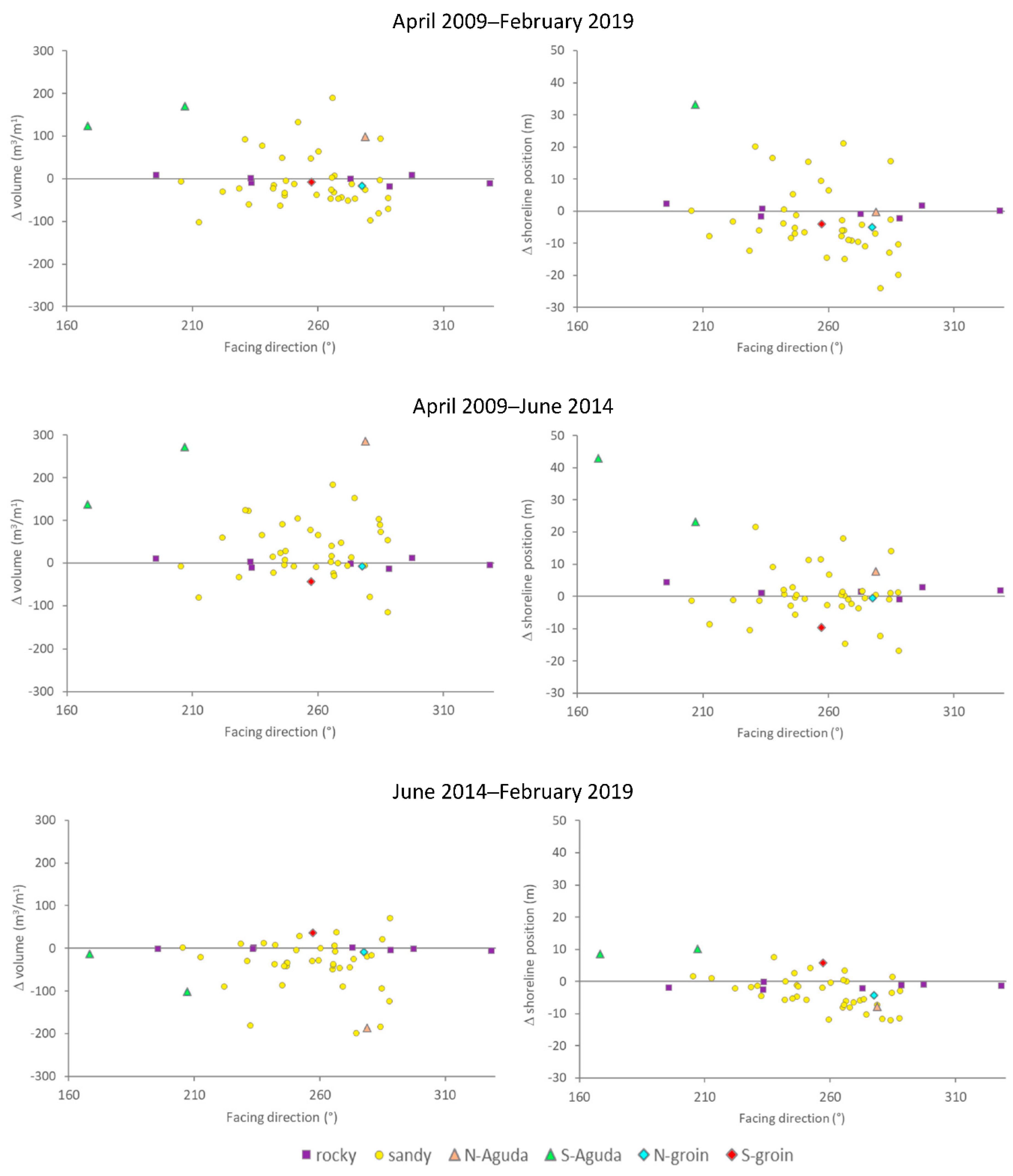

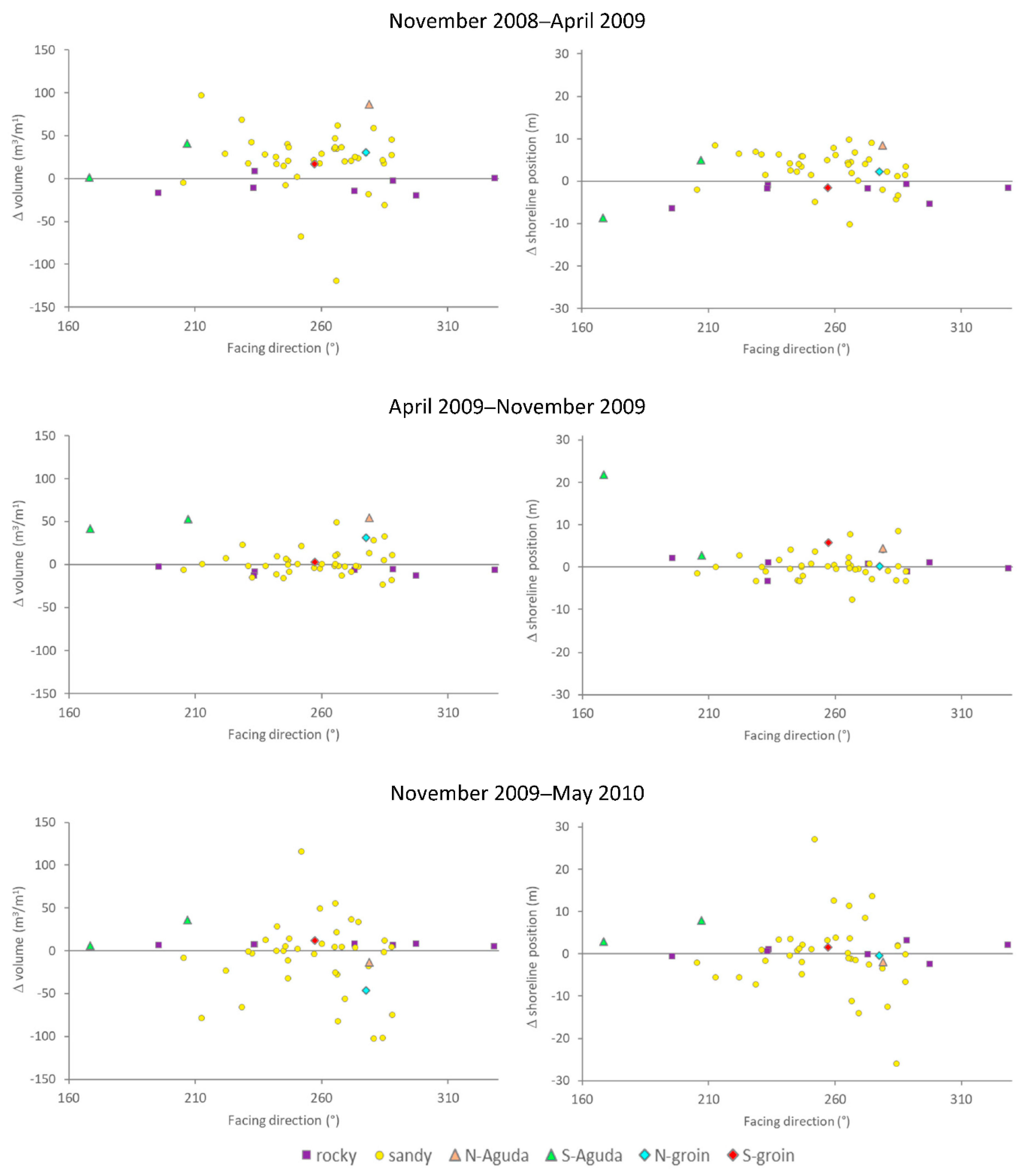
| Dates | Period | ∆ Volume (m3) | ∆ Shoreline (m) | |
|---|---|---|---|---|
| November 2008–April 2009 | Season: winter | 223,094 | +2.9% | 2.7 |
| April 2009–November 2009 | Season: summer | 108,848 | +1.4% | 0.7 |
| November 2009–May 2010 | Season: winter | −6889 | −0.1% | 1.2 |
| May 2010–June 2014 | −54,483 | −0.7% | −0.4 | |
| June 2014–May 2018 | 90,981 | 1.2% | −3.3 | |
| May 2018–February 2019 | 1 year (approx.) | −89,372 | −1.1% | 0.2 |
| November 2008–November 2009 | 1 year | 331,942 | +4.4% | 3.3 |
| April 2009–May 2010 | 1 year | 101,959 | +1.3% | 1.9 |
| April 2009–June 2014 | 5 years | 47,476 | +0.6% | 1.5 |
| June 2014–February 2019 | 5 years | 1608 | 0.0% | −3.1 |
| April 2009–February 2019 | Decade | 49,084 | +0.6% | −1.6 |
Publisher’s Note: MDPI stays neutral with regard to jurisdictional claims in published maps and institutional affiliations. |
© 2022 by the authors. Licensee MDPI, Basel, Switzerland. This article is an open access article distributed under the terms and conditions of the Creative Commons Attribution (CC BY) license (https://creativecommons.org/licenses/by/4.0/).
Share and Cite
Bio, A.; Gonçalves, J.A.; Iglesias, I.; Granja, H.; Pinho, J.; Bastos, L. Linking Short- to Medium-Term Beach Dune Dynamics to Local Features under Wave and Wind Actions: A Northern Portuguese Case Study. Appl. Sci. 2022, 12, 4365. https://doi.org/10.3390/app12094365
Bio A, Gonçalves JA, Iglesias I, Granja H, Pinho J, Bastos L. Linking Short- to Medium-Term Beach Dune Dynamics to Local Features under Wave and Wind Actions: A Northern Portuguese Case Study. Applied Sciences. 2022; 12(9):4365. https://doi.org/10.3390/app12094365
Chicago/Turabian StyleBio, Ana, José Alberto Gonçalves, Isabel Iglesias, Helena Granja, José Pinho, and Luísa Bastos. 2022. "Linking Short- to Medium-Term Beach Dune Dynamics to Local Features under Wave and Wind Actions: A Northern Portuguese Case Study" Applied Sciences 12, no. 9: 4365. https://doi.org/10.3390/app12094365
APA StyleBio, A., Gonçalves, J. A., Iglesias, I., Granja, H., Pinho, J., & Bastos, L. (2022). Linking Short- to Medium-Term Beach Dune Dynamics to Local Features under Wave and Wind Actions: A Northern Portuguese Case Study. Applied Sciences, 12(9), 4365. https://doi.org/10.3390/app12094365







